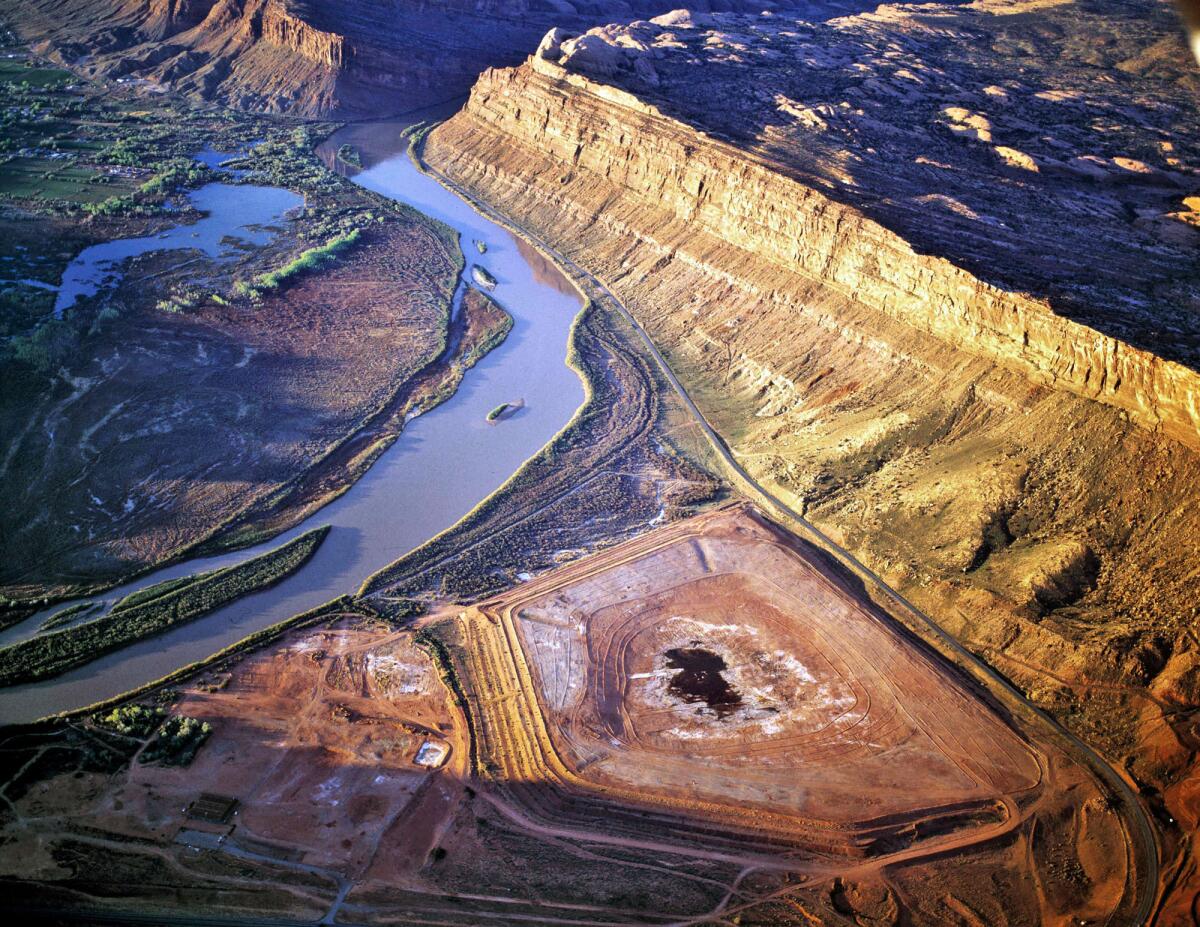Colorado River researchers find signs of ancient, devastating floods

- Share via
Scientists say it would have been a catastrophe of unprecedented proportions. If the Glen Canyon Dam had failed, it would have changed the lives of millions of people and reshaped the history of the American West.
Only a lucky break in the weather spared the dam in June 1983, as floodwaters coursed through the Colorado River and its tributaries. They pooled in Lake Powell, causing water levels to creep upward at a rate of 3 inches per day.
To avert disaster, engineers tried to shed water through the underground spillways, but the dam began to shudder and groan. The reason soon grew apparent: The water gushing from the base of the dam emerged as a red slurry of sediment flecked with chunks of ancient sandstone. The dam was being eaten away from below.
Now, geologic evidence suggests that the 1983 flood would have paled in comparison to events that occurred long before people started keeping track. These floods were larger and more frequent than modern estimates suggest, according to a paper published online recently in the journal Water Resources Research.
“If we’re thinking about rare, giant flood events, we need to look at more time than the decades represented in a normal stream gage,” said Victor Baker, a study author and geologist at the University of Arizona.
Researchers contend that the short period of instrumental observations might miss extreme floods that happen only once a century, or even once a millennium.
To get a better perspective on ancient water levels, Baker and his colleagues floated down the Colorado River in search of spots where sediments might trap evidence of paleofloods. Signs of high water levels included driftwood deposits, or layers of fine silt that would otherwise be swept away by the river’s swift currents.
The scientists settled on a site near the mountain biking mecca of Moab, Utah, where the river tumbles through a deep canyon of layered crimson bedrock. The shape of the canyon has most likely remained the same for a few millenniums, meaning the scientists can compare flood heights in the past to flood heights measured today.
When the scientists dated the deposits, they tallied more than 40 large floods in the last 2000 years. Of these, 34 exceeded floods expected to strike once a century, and 26 dwarfed the so-called 500-year flood.
That means that although current models predict truly epic floods twice every millennium, there really might be as many as 13.
Researchers say two massive paleofloods proved even worse than scenarios now used by engineers and planners to prepare for future disasters.
After being retrofitted in 1984, the Glen Canyon Dam remains unprepared for the maximum flood size predicted by theory, Baker said, let alone the beasts he discovered.
The disparity between the paleoflood record and modern estimates of flood size and frequency may be due to several reasons.
First, Baker said, sediments do a good job of preserving big floods but flood gages don’t; if they do happen to record a big event, they often break.
Second, without a robust data set of rare, severe floods, scientists using gage records must extrapolate what they know about small, annual floods to make predictions about extreme events.
“You are trying to estimate the tail of the distribution from the middle of the distribution,” said Jim O’Connor, a hydrologist at the U.S. Geological Survey in Portland, Ore., who was not involved in the study.
He says finding just one or two big events in a thousand-year interval improves scientists’ understanding of flood probabilities as much as several centuries of gage measurements.
“It’s not something theoretical,” said Noam Greenbaum of the University of Haifa in Israel, the lead author of the study. “What we are actually documenting are the natural floods.”
Determining these natural levels can be tricky, though.
In the last century, more than 100 dams have sprung up between the Colorado’s snowy headwaters in the Rocky Mountains and its delta in Mexico. The river now quenches the needs of seven thirsty states and two countries. It is hardly the same river today that it was when these floods occurred.
Using information about paleofloods poses the risk that decisions “could be made based on conditions of the past that are not applicable for the future,” wrote the Army Corps of Engineers in a 2013 report that expressed mixed feelings about the utility of paleoflood records for modern risk assessment.
But Baker thinks this does not merit excluding the data. It is common sense, he said, that what has happened could happen again.
The changes that have transformed the Colorado don’t necessarily decrease the chances of large floods. Engineers did not design its dams for flood control, they sought to provide water storage and hydropower — “and that works best when dams are full,” Baker said. As illustrated by the events of 1983, purging water from the reservoirs before a flood hits presents its own set of challenges.
On top of all that, the specter of climate change looms over the river and its uncertain future.
“Nature is variable,” Baker said. The Southwest has suffered in the wake of recent droughts, but the long-term history of the region suggests that can change quickly.
“If we are entering a phase because of our changing climate where the extremes are being enhanced, we could see a period of extreme wet,” Baker said, “It may sound like a good thing, but it would be a serious hazard concern.”
Greenbaum cites the uncertainty of future change as a strong argument to seek out long-term flood records to complement the gage measurements of the 20th century.
“During the last 2,000 years, the climate changed a lot. It was maybe sometimes wetter, different periods were dryer,” he said. “Two thousand years is the best record you can have to show what really happened and this is a much more firm basis if you want to predict the future.”
In the end, however, Baker and Greenbaum agree that it’s not up to scientists to decide what to do with this knowledge; it’s a job for engineers.
But they do think the record deserves some attention.
“Ignoring Mother Nature is not too smart,” Baker said, “but that’s just a personal opinion.”
For all things science, follow me @ScienceJulia.







